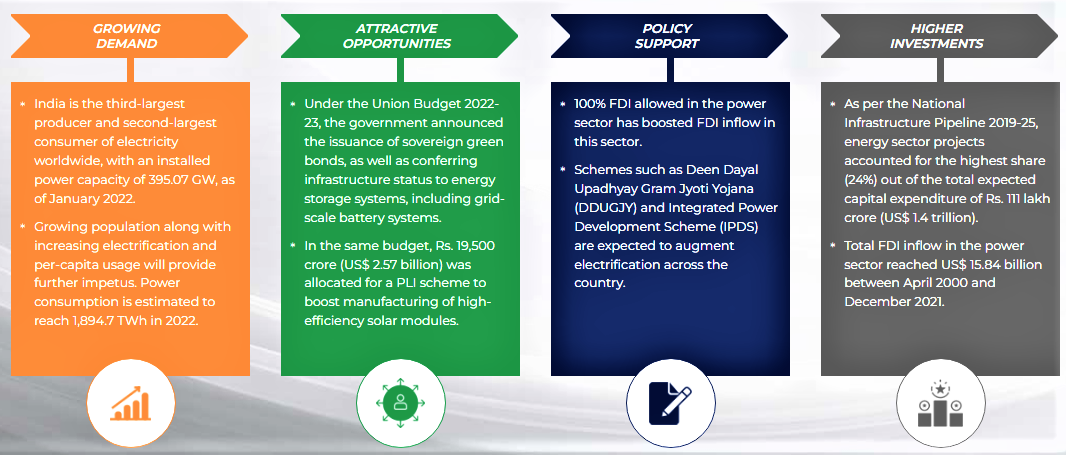What is the issue?
While the significant growth of power infrastructure is commendable, there are many problems that the sector faces, electrical accidents being a tragic one.
What is the status of power sector in India?
India is the third-largest producer and second-largest consumer of electricity worldwide.
- Status of power sector- India's power sector is one of the most diversified in the world with sources of power generation range from conventional sources to viable non-conventional sources.
- India was ranked fourth in wind power, fifth in solar power and fourth in renewable power installed capacity, as of 2020.
- India is the only country among the G20 nations that is on track to achieve the targets under the Paris Agreement.
- Market size- The Government of India's focus on attaining 'Power for all' has accelerated capacity addition in the country.
- As of January 2022, India's installed renewable energy represents 38.56% of the overall installed power capacity.
- Investment- Total FDI inflow in the power sector accounts for 2.77% of the total FDI inflow in India.
The Central Electricity Authority (CEA) estimates India's power requirement to grow to reach 817 GW by 2030. The government plans to establish renewable energy capacity of 500 GW by 2030.

What are the problems in the electricity sector?
- Electrical accidents- The increasing rate of electrical accidents is a problem that has not received sufficient attention of those who plan, regulate and operate the electricity sector.
- As per the data from National Crime Records Bureau, the rate of deaths (per lakh population) due to electric shocks and fires has increased to 1.13 deaths per lakh population in 2020.
- People who die due to electrical accidents- Over 90% of then are general public.
- Geography- Most of the electrical accidents appear to be taking place in rural areas.
- Electrical terms- Most accidents occur in the distribution system and at non-industrial consumer locations.
- Fatalities- Most fatalities occur at distribution network (specifically 11 kV and Low-Tension systems) and Low-Tension consumer locations.
- Immediate cause for accidents- Electrocution due to accidental contact with live conductors followed by electrical faults.
- Other root causes- Poor design, construction, inadequate maintenance, inadequate protection systems and lack of safety awareness.
- Resource allocation- National or State policies or programmes do not provide targets or specific resource allocation for safety.
- In some cases where resource is allocated, it is under-utilised or a small portion is spent on staff for safety kits or training.
What is the issue in following the safety regulations?
- There are safety regulations prepared by the Central Electricity Authority (CEA) which all electricity utilities are expected to follow but there is no mechanism to ensure that utilities are following them.
- Distribution companies are expected to have safety officers and conduct periodic safety audits but they are not done because revenue collection and fault repairs are higher priorities for the companies.
- Electrical inspectors in States are expected to approve connections, provide licences to electricians and conduct enquiries on accidents but they are heavily under-staffed.
- As for safety professionals, their focus is on industrial safety, and not on safety aspects of the rural public.
- Many well-meaning grass-root organisations focus on ensuring ex gratia for accident victims, not on accident prevention.
Central Electricity Authority (CEA) is an organization under Ministry of Power whose functions and duties of CEA are delineated under Section 73 of the Electricity Act, 2003.
What is the need of the hour?
- Multi-stakeholder approach- Electricity safety is a public interest challenge, which can be met only through coordinated action involving all stakeholders.
- Improved interventions- There is a need for better data collection, new safety aspects in national programmes, strengthening safety institutions, developing safety metric for distribution companies, involving public and professionals in safety initiatives and utilising technological innovations.
- National plan on electrical safety- The need of the hour is a national programme to reduce electrical accidents in the distribution sector, with clear scope of work and sufficient resource allocation.
- Targeted approach- States could identify districts which have reported high accidents in the past few years and chalk out a programme to reduce accidents.
